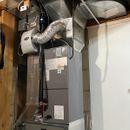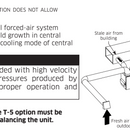Want to add ERV to central HVAC
Greetings,
I’ve had a lot of good help from the folks on this forum when I was planning a replacement central HVAC system. I have had my new 2-ton Carrier 40MUAA and 38MURA heat pump system for a year now and it’s working great for both heating and cooling.
House Size: 2 storey plus basement, 2100 sqft total
House Age: 1966
Winter Design Temperature: -4F
Design Heating load: 27,952 BTU/h
ACH@50: 4
Climate: USDA Zone 5 (Toronto, Ontario)
As I continue on the journey to improve the efficiency and health of my house I would like to do air sealing/insulation of my rim joists and add an ERV at the same time, since my indoor air quality is already borderline and more air sealing will probably make it worse.
Bedroom Co2 at night: 1000-2000 ppm
Unfortunately I don’t have the budget, and the house isn’t really conducive to the installation of another set of ducts (the current hvac ducts were retrofitted in 1995 by a previous owner, so I already have bulkheads and whatnot). Therefore, I’m hoping to choose a practical ERV and installation method that will work. I’m not too concerned about running my air handler’s blower nearly constantly since I already do that to mix the air and even up the temperature on the different levels and from what I read, these ECM blowers were designed to do this.
I have been reading the install manual for VanEE’s AI series and it seems that the T-5 installation method (see attached image) is the one that would suit my house best. It would be great to get some opinions from the experts on this forum though, to confirm this or suggest something different.
I’m also attaching a pic of my air handler and ducting which you’ll see is pretty compact. The return duct goes straight up and connects to a combined plenum/panned joist to reach the living room return grille 2 feet over. The same return plenum connects to a large duct going up to the top of the 2nd floor and also to a small grille in the basement rec room.
I’m also hoping to remove the humidifier if the results of the rim joist air sealing allow it.
Thanks!
GBA Detail Library
A collection of one thousand construction details organized by climate and house part











Replies
If you're already running the air handler continuously then the t-5 setup should work fine. I did an independent duct setup because my air handler uses 500 watts per hour despite being an ecm motor. If your HVAC is variable speed or at least multiple speeds the air handler likely uses much less energy than my single stage heat pump. My broan 210 ERV uses 23 watts per hour providing 65 cfm.
You'll likely still want the humidifier for the colder/drier parts of winter in TO. Adding an ERV will increase your ventilation rate, so regardless of being an ERV (they recover some moisture, but not all of it), you may still want to add some humidity in winter.
I would go with the T5 method. I would also install external filtration for the ERV as it looks like you have room for it. That way you can take advantage of the benefits of larger/cheaper filters, while maintaining or improving efficiency.
You haven't mentioned external ducting, but you'll want them 10 feet apart and well away from external gas venting etc. Use 6" ducting for the external to allow for boost in that 140-180 CFM range. I'm assuming this is a typical single family dwelling based on those heat load values.
Thanks both! I'll plan on keeping the humidifier then, for now.
It is a typical SFD yeah. The external ducting will be a challenge here too, since the front of the house is a full length verandah, one side is a full length attached garage, and the 3rd side is perpendicular to joists and has many obstructions, leaving the 4th side which has all of the house's other venting (dryer vent, 2 bathroom vents, 1 kitchen vent, 1 gas vent for the hot water heater, and the gas meter). Still haven't figured this part out !
I liked the external filtration option, will have to set that up.
I was having a conversation about this on a different forum and people are generally recommending not to use the T-5 method since the incoming fresh air won't have a chance to be conditioned by the air handler's coil. They suggested the T-2 method, and running a new duct/grille to some place to pick up stale air. The challenge is... where?
Here's a floor plan of my house, it's 3 identically sized stacked floors, 2 above ground and 1 basement... in case anyone has ideas for me !